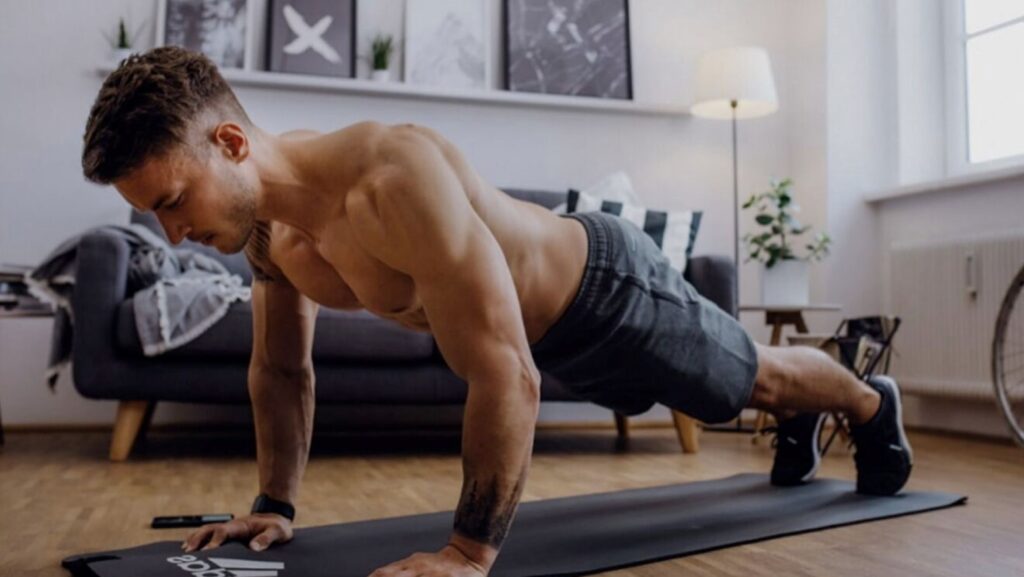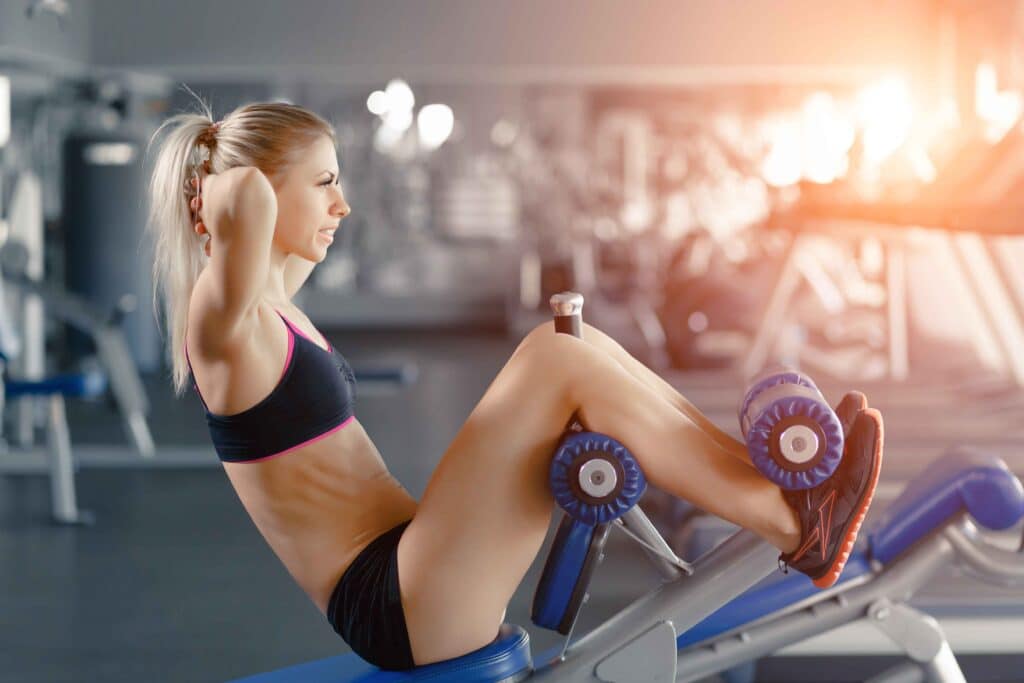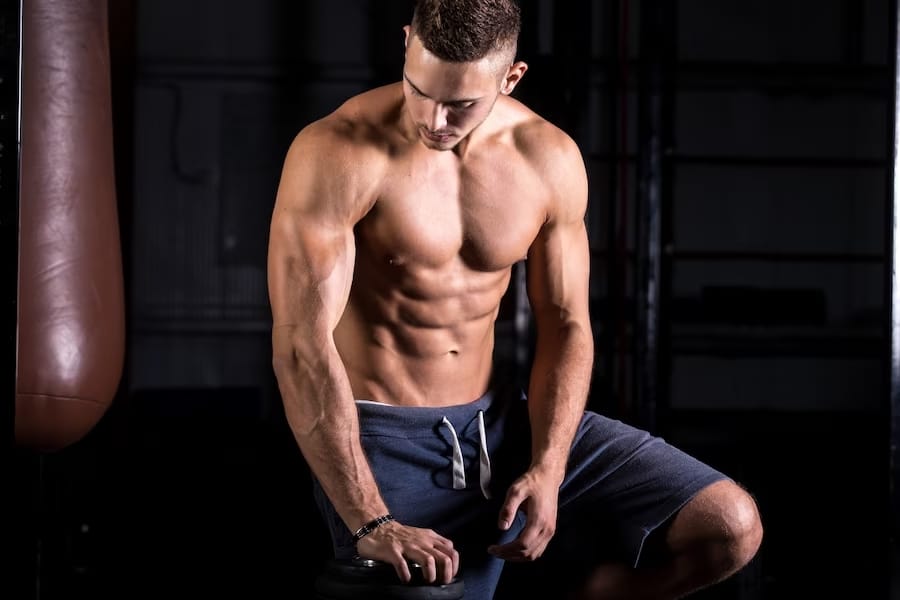Are you looking to give your shoulder muscles the attention they deserve? If so, compound shoulder exercises are incredibly effective at strengthening and toning the shoulders while also helping in the activation of core muscles.
In this blog post, we’ll take a deeper dive into compound shoulder exercises and why you should start making them part of your workout routine today.
Whether you’re an experienced weightlifter or new to strength training, these workouts can help get you moving and feeling stronger in no time.
So read on for some great advice for building strong shoulders with compound movements:
Best Compound Shoulder Workouts
These exercises will help up your shoulder training game:
1. Pike Push Up

It’s important to maintain proper form throughout this compound shoulder exercise.
If you’re new to pike push-ups or find them challenging, you can modify the exercise by placing your hands on an elevated surface, such as a bench or step, to reduce the intensity.
Step-By-Step Guide
- Start in a push-up position with your feet together and your palms slightly wider than shoulder-width apart on the ground.
- Walk your palms backward towards your feet while simultaneously lifting your hips and forming an inverted V with your body. Your head and limbs should be aligned.
- Ensure that your arms and legs are straight and that your heels are as near as possible to the ground. This is the beginning position.
- As you bend your elbows and lower your upper body towards the earth, inhale. Keep your head facing down and your core firm.
- Once your head is just above the ground or as low as you can comfortably go, exhale and press through your palms to return to the starting position.
- Perform the intended number of repetitions of the movement.
Pro Tips
- Engage your core muscles to stabilize your body and prevent excessive sagging or arching.
- Gradually increase the range of motion as you gain strength, aiming to lower your head as close to the ground as possible while maintaining proper form.
- To make Pike Push-Ups more challenging, elevate your feet on an elevated surface like a box or bench.
- If you’re a beginner, start with modified versions like wall Pike Push-Ups or incline Pike Push-Ups until you build sufficient strength.
2. Parallel Bar Dips

Parallel bar dips are a compound exercise that primarily targets the triceps, chest, and shoulders.
They are performed using parallel bars, which are typically found in gyms or can be set up using dip bars or parallettes.
Step-By-Step Guide
- Stand between the parallel bars to start. Make sure your hands are shoulder-width apart and that you have a strong grip on each bar with your palms facing down.
- Push down on the bars and raise your arms to pull yourself up. This is where you start, with your feet off the ground and your arms fully stretched.
- Bend your arms and slightly lean forward to lower your body. Keep your spine straight, and don’t lean too far forward.
- Continue going down until your shoulders are level with or just below your hands. This will give you a full range of motion. Keep your balance and try not to bounce at the bottom.
- Pause quickly at the bottom, then push through your hands and extend your elbows to get back to the starting position.
- Repeat the movement for the desired number of repetitions.
Pro Tips
- Focus on maintaining tension in your triceps and chest muscles as you push yourself up, rather than relying solely on your shoulders.
- Gradually increase the depth of your dip by lowering yourself until your shoulders are below your elbows, but avoid excessive stress on the shoulder joint.
- If you’re new to parallel bar dips, start with assisted variations using resistance bands or a dip machine to build strength before progressing to bodyweight dips.
- Experiment with different hand positions, such as wider or narrower grips, to target different muscle groups and find what feels most comfortable for your shoulders.
3. T-Bar Rows

T-bar rows are an effective exercise for strengthening the posterior deltoids, which can help improve shoulder stability and posture.
Incorporating T-bar rows into your workout routine can contribute to better shoulder aesthetics and provide a foundation for performing other pressing and pulling movements with greater efficiency.
- Place a barbell in a landmine or secure it in a room corner with a barbell attachment. Load the proper weight plates onto the barbell’s other end.
- Straddle the barbell with your feet shoulder-width apart, facing the weighted end. Bend your knees slightly and lean forward at the hips, keeping your back flat.
- With your hands facing down, reach down and grab the handle or end of the barbell with an overhand grip. Hands should be shoulder-width or slightly wider apart.
- Lift the barbell slightly off the ground, keeping your arms straight and your back flat. This is where you’ll begin.
- Inhale and retract your shoulder blades to pull the barbell towards your chest. At the height of the exercise, keep your elbows tight to your body and squeeze your back muscles.
- Exhale as you slowly lower the barbell back to the starting position with your arms fully extended.
- Repeat the movement for the desired number of repetitions.
Pro Tips
- Engage your core muscles to stabilize your body and prevent excessive swinging or momentum.
- Focus on pulling with your back muscles rather than relying on your arms or biceps.
- Keep your elbows close to your body to emphasize the back muscles and minimize strain on your shoulders.
- Control the movement and avoid jerking or using momentum to lift the weight.
- Adjust the weight load as needed to maintain proper form and challenge yourself without sacrificing technique.
Compound Shoulder Exercises With Dumbbells
These are some of the best dumbbell compound shoulder exercises that are sure to produce results:
4. Arnold Press

The Arnold press is a popular shoulder compound workout named after the legendary bodybuilder Arnold Schwarzenegger.
It targets multiple shoulder muscles, including the deltoids (front, middle, and rear heads), trapezius, and triceps.
Step-By-Step Guide
- Begin by sitting on a bench with back support, or execute the exercise standing up with appropriate posture.
- Hold a dumbbell in each hand, palms towards your body, at shoulder level. Bend your elbows and keep your forearms perpendicular to the floor. This is where you’ll begin.
- Begin by turning your palms outward while pressing the dumbbells overhead. Rotate until your palms face front at the top of the action.
- Extend your arms fully without locking your elbows as you press the dumbbells upward. Keep your core engaged and your back straight.
- Pause for a second at the top to feel the contraction in your shoulders.
- Lower the dumbbells slowly back to the starting position while rotating your hands back to the starting position, facing your body.
- Repeat the movement for the desired number of repetitions.
Pro Tips
- Start with lighter weights to ensure you can perform the exercise with the correct form, and gradually increase the weight as you gain strength.
- Keep your core engaged and maintain a stable, upright posture throughout the exercise.
- Control the movement and avoid using momentum to lift the dumbbells.
- Exhale as you press the dumbbells upward, and inhale as you lower them back down.
- Focus on feeling the contraction in your shoulder muscles throughout the exercise.
5. Seated Dumbbell Press

As a compound movement, the seated dumbbell press works not only the shoulders (deltoids), but also the triceps and upper chest.
It is a dumbbell compound shoulder workout that is done while seated on a bench or chair with back support.
Step-By-Step Guide
- Start by sitting on a chair with a straight back or a bench with back support. Put your feet flat on the ground, about the width of your hips apart.
- Hold a dumbbell in each hand, with the palms facing forward and the weights at shoulder height. Your arms should be parallel to the ground and bent at the elbows. This is where you’ll start.
- Stay engaged in your core and keep your back straight throughout the workout.
- Exhale and push the dumbbells up by fully stretching your arms and keeping your elbows from locking. Focus on using your arm muscles and stay in charge.
- At the top of the move, stop for a moment and feel your shoulders tighten.
- Inhale as you slowly bend your arms to bring the dumbbells back to the starting position.
- Repeat the action for as many times as you want.
Pro Tips
- Avoid using momentum or jerking your body to lift the dumbbells. Focus on controlled and smooth movements.
- Keep your wrists neutral and avoid excessive bending or extension.
- Engage your core muscles throughout the exercise to maintain stability and support your spine.
- Breathe out as you push the dumbbells upward, and breathe in as you lower them back down.
Over To You
So, to sum it up, compound shoulder exercises are an effective way to build strength and increase the overall health of your arms and shoulders.
Don’t forget adding progressive overload principles to your workouts.
And as always, if you have any questions about what kind of shoulder exercises you should incorporate into your routine or any other grip-related questions, ask away in the comments section.
Remember to keep checking Lifter’s Digest blogs for updates on the latest following grip training trends.
And until next time, my friends, keep those arms swole and those hands strong.





